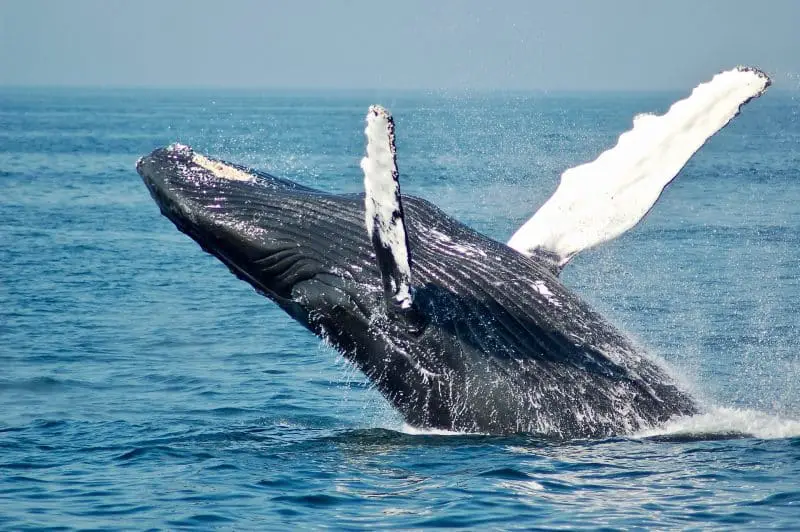Humpback whales are famous for their beautiful, almost eerie songs, their incredible sizes, and their worldwide migration patterns.
Introduction
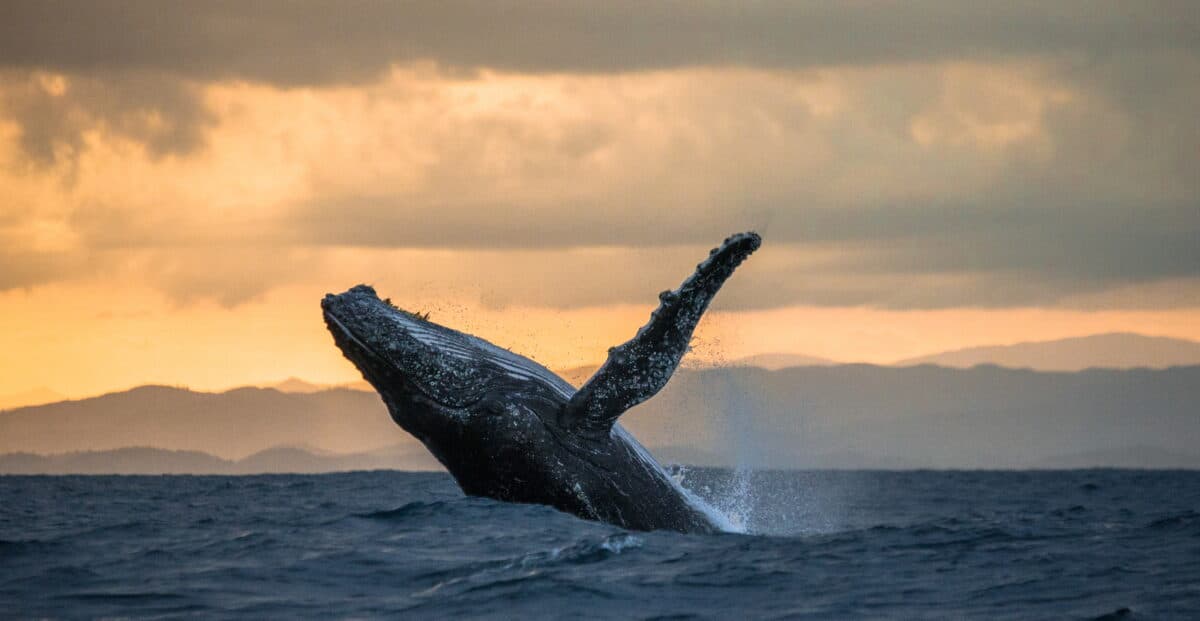
Humpback whales are distributed across all the world’s oceans. Their Latin name, Megaptera novaeangliae, translates to “big wing of New England,” referencing their large pectoral fins, which can reach up to 16 feet in length.
This name stems from their sightings off the New England coastline, where European whalers initially encountered them. Recognizable by their dark backs, light-colored bellies, throat pleats, and a small hump ahead of their dorsal fin, these whales are commonly known as “humpbacks.”
10 Quick Facts
- Humpback whales sometimes blow bubbles to create “fishing nets” to trap their food.
- Humpback whales in the Arabian Sea are the only ones which don’t migrate to polar waters to eat.
- Humpback whales are relatively slow swimmers.
- Humpback whales spend roughly 90% of their time beneath the waters surface.
- The Humpback whales baleen is made up of keratin, the same substance that makes up human hair and fingernails.
- Only male Humpbacks “sing”; their song is the most complex in the animal kingdom.
- Every humpback whale has a unique pattern of pigment and scars on its underside.
- Mothers and their young swim close together, often touching one another with their flippers with what appear to be gestures of affection.
- Calves do not stop growing until they are ten years old.
- Humpbacks usually travel alone or in small groups called pods of two to three whales.
Best Places to See Humpback Whale in the Wild
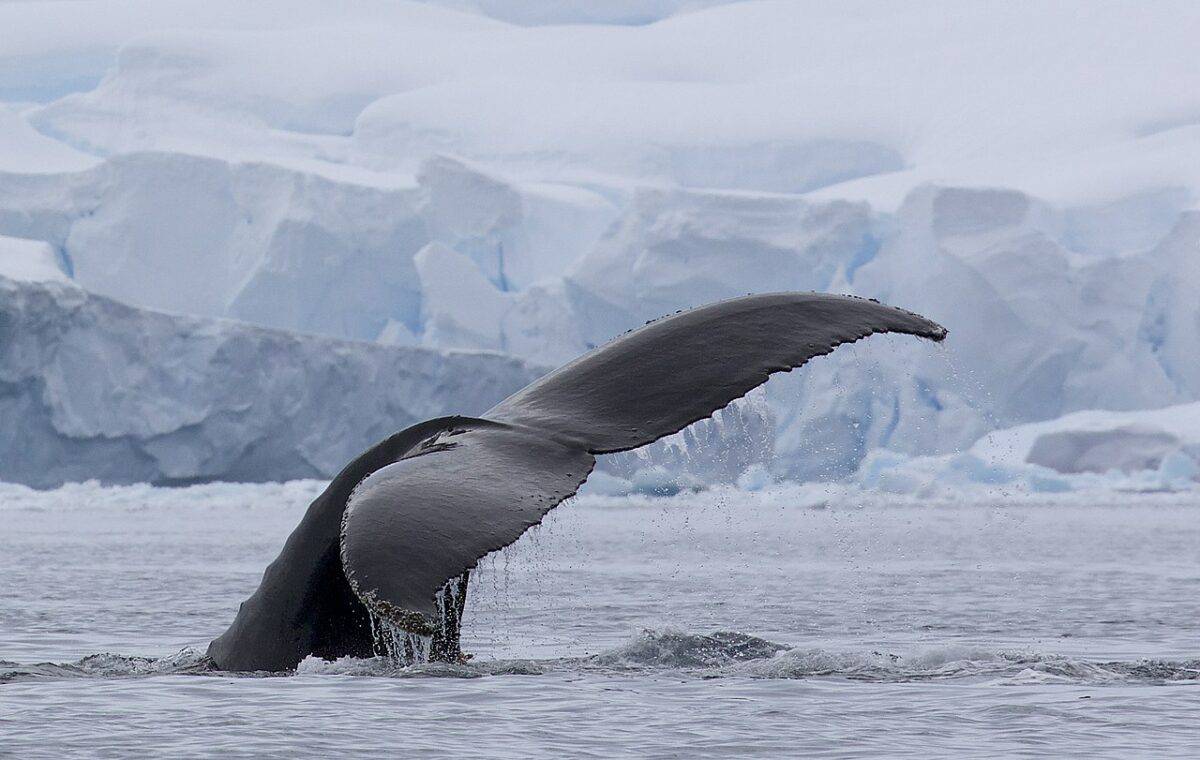
Are you interested in seeing these amazing whales for yourself? We have compiled a list of a few organisations we believe will help you on your mission to see them in the Wild:
Tofo, Mozambique
Liquid Dive Adventures is based in the region of Tofo, their expertise and respect for this whale species is admirable!
South Africa
Ocean Odyssey is a tour operator based in South Africa – a major hub of whale populations. Their dedication to whale conservation is awesome!
Characteristics
| Characteristic | Description |
|---|---|
| Size | Adults range from 40–52 feet (12–16 m) in length |
| Weight | Adults weigh around 25–40 tons |
| Lifespan | Average of 45–50 years |
| Feeding | Filter feeder, primarily feeds on krill and small fish |
| Dorsal Fin | Prominent, hump-shaped dorsal fin |
| Singing | Known for complex songs sung by males |
| Migration | Undertakes long-distance migrations, traveling thousands of miles |
| Conservation Status | Least Concern |
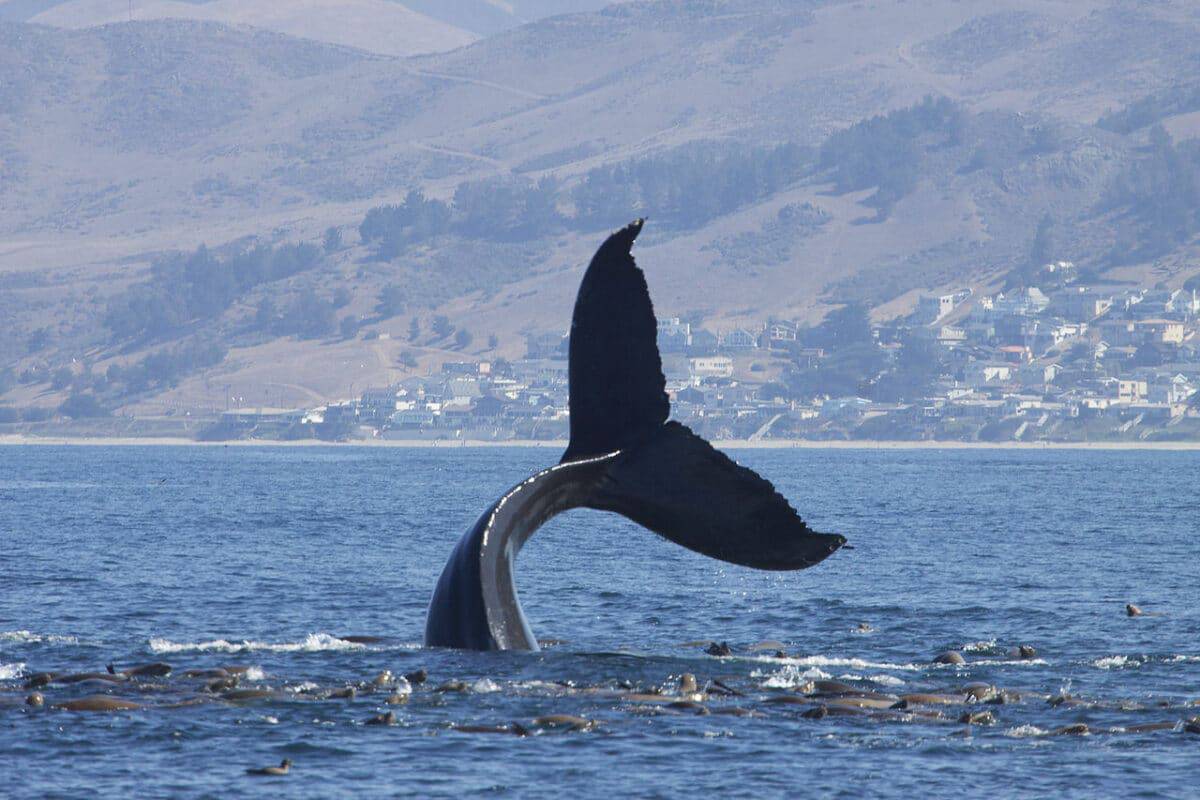
Humpback whales reach lengths of approximately 52 feet (16 meters) and weigh between 30–50 tons. Typically, females are slightly larger than males, a common trait among baleen whales. The average humpback whale’s four-chambered heart weighs around 430 pounds.
Humpbacks also have huge, mottled white flippers with rough edges that are up to one-third of its body length. Humpback whales display four distinct color variations, spanning from white to gray, black, and mottled. These variations feature noticeable patches of white on the underside of their flukes (tails).
These markings are unique to each individual whale, like a fingerprint. The humpback’s skin is frequently scarred and may have patches covered with barnacles.
Humpback whales have 14 to 35 throat grooves that facilitate the expansion of their throat during filter feeding. They also exhibit small, round bumps called knobs or tubercles along the edges of their jaws on the front of their heads.
The physical features of these whales are what defines them and makes them recognisable. The size of these whales can be associated with roughly the same size of a school bus.
Key points
| About | Key Points |
|---|---|
| Characteristics | – Humpback whales are found in every ocean in the world. |
| – They have dark backs, light bellies, pleats on their throats, and a small hump in front of their dorsal fin. | |
| – Humpback whales grow to be about 52 feet (16 m) long, weighing 30-50 tons (27-45 tonnes). | |
| – They come in 4 different color schemes and have distinctive patterns unique to each individual whale. | |
| Whale Songs | – Humpbacks are known for their magical and complex songs that can travel for great distances. |
| – Songs are likely used for communication and attracting mates. | |
| Behavior & Parenting | – Humpbacks migrate annually between summer feeding grounds and winter breeding waters. |
| – Mothers and calves swim closely together, and calves grow until they are ten years old. | |
| Swimming & Breaching | – Humpbacks are powerful swimmers and regularly leap from the water. |
| – They engage in various behaviors like slapping the water and penducle throws. | |
| Habitat & Ecology | – Humpbacks make seasonal migrations between high latitude summer feeding grounds and low latitude wintering grounds. |
| – They prefer swimming in deep waters and hugging coastlines due to food availability. | |
| Best Places to See | – Tofo, Mozambique: Liquid Dive Adventures |
| Humpback Whales | – South Africa: Ocean Odyssey |
| Diet | – Humpbacks filter-feed on krill, anchovies, cod, and other schooling fish. |
| – They use bubble nets to trap prey. | |
| Breeding | – Courtship behaviors are complicated, and females nurse calves for about a year. |
| – Calves grow rapidly and can double in size in their first year. | |
| Conservation | – Humpback whales were once close to extinction due to whaling. |
| – The current humpback population is around 80,000, classified as “least concern” on the IUCN Red List. | |
| – They still face threats from illegal whaling, noise pollution, ship collisions, and entanglement with fishing gear. |
Whale songs

These whales are renowned for their enchanting songs that traverse vast distances across oceans. These sounds can persist for hours. Scientists continually study these melodies to understand their significance.
It’s believed that humpbacks use their songs to make contact with other whales and potentially attract mates. This form of communication shows their remarkable intelligence, Dolphins and other members of the whale family are also known for the sounds they use to communicate.
Humpback whale songs are shared among all singing members in the same ocean area. As the song changes, all members adapt to the new tune. Despite great distances between groups in the population, sometimes up to 5,000 km apart, this shared song remains consistent. This sharing likely happens during migration or when whales gather in common summer feeding areas.
The whales are known for their intricate and diverse songs, predominantly sung by males. These songs, featuring sequences of squeaks, grunts, and various sounds, have a broad frequency range from 20–9,000 Hertz. Males typically sing these complex songs in warm waters, potentially for mating purposes. In colder waters, they produce rougher sounds like scrapes and groans, possibly used for finding large groups of krill, their main food source.
Behavior and Parenting
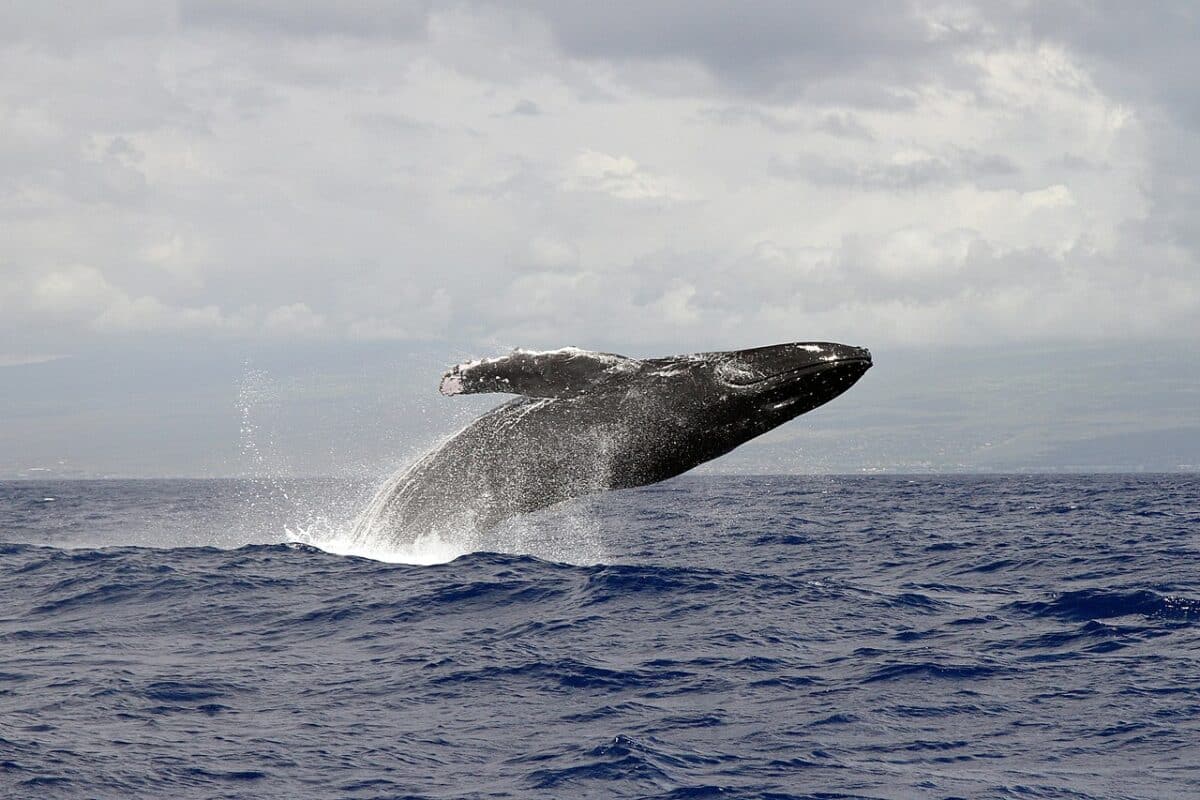
These baleen whales, known for their filter-like mouth structure, inhabit coastal regions where they feed on tiny krill, plankton, and small fish. Humpback whales migrate annually from their feeding grounds near the poles to warmer breeding waters closer to the Equator.
Mother whales and their young swim in close proximity, often touching each other with their flippers, displaying what seems to be signs of affection. Female whales nurse their calves for about a year, but it takes a considerably longer time for a humpback whale to reach full maturity. The growth of calves continues until they reach around ten years of age.
It is believed that these animals share a close bond with their offspring and are very protective. If ever sighting a whale, it is important to ensure one never goes between the mother and calf.
The chances are, the humpback whale will respond in a protective and aggressive manner.
Swimming, Breaching, and Displays
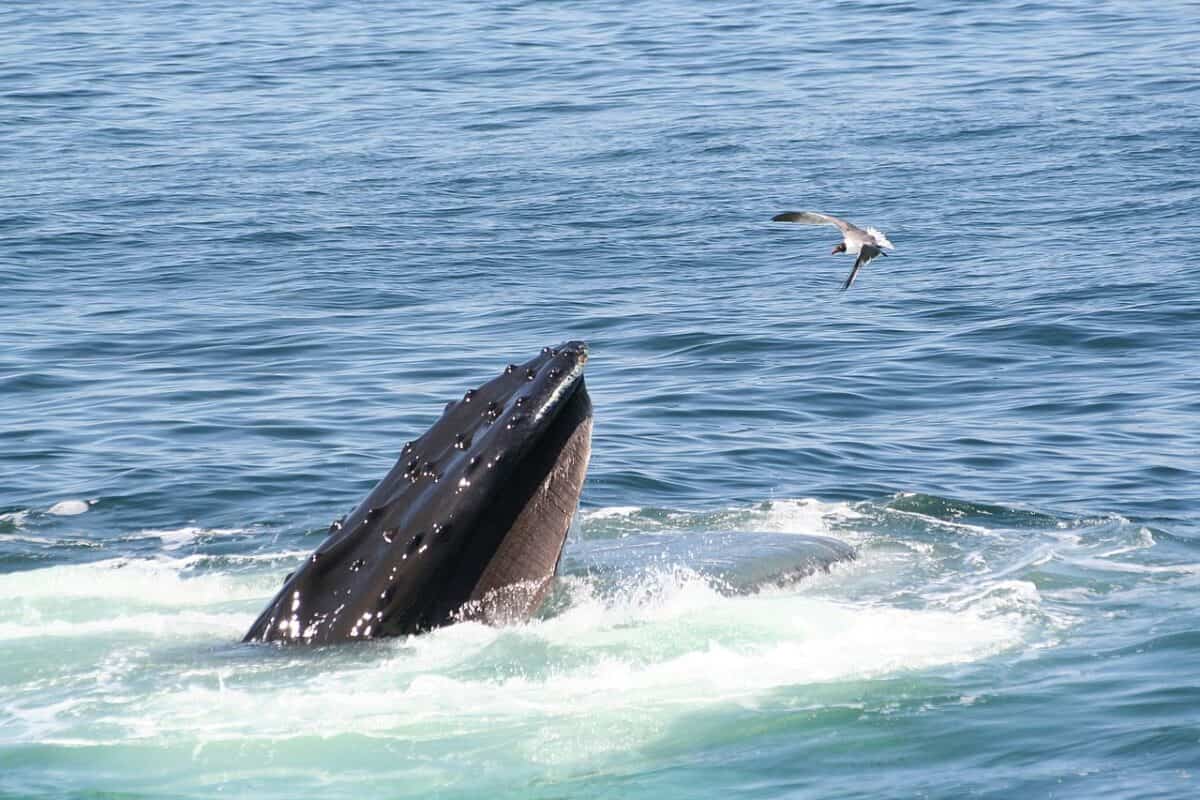
Humpback whales are adept swimmers, utilizing their enormous tail fin, known as a fluke, to navigate through water, occasionally propelling themselves entirely out of it.
Similar to other whale species, these creatures frequently breach, launching themselves out of the water and creating massive splashes upon landing. Scientists investigating their behavior remain uncertain whether this breaching serves a specific purpose, such as cleaning pests from the whale’s skin.
Whale enthusiasts enjoy watching humpback whales engage in various behaviors. They also exhibit “spyhopping,” where they lift their entire hind body and tail above the water, twisting, and forcefully striking their lower half onto the ocean surface.
Less commonly observed displays include flapping their fins in a wing-like manner and occasionally congregating in large “super groups” of up to 200 whales.
Scientists studying their behaviour have many myths to bust and understanding to gain on humpback whales behaviour. But, perhaps this is what makes them quite special. They are mysterious and fascinating, wether we understand what they do or not.
Habitat & Ecology
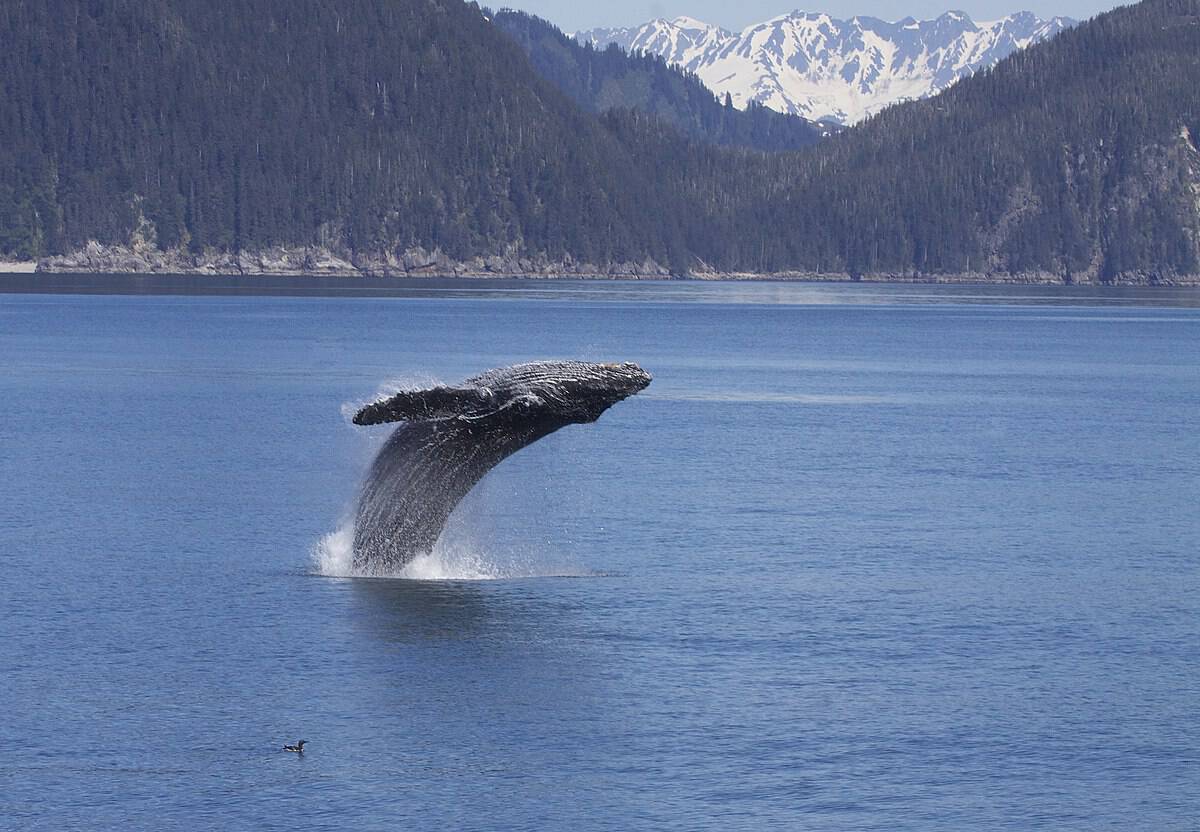
Humpback whales undergo lengthy seasonal migrations, traveling between summer feeding areas in high latitudes and wintering grounds in low latitudes. They spend winters mating and giving birth in warm sub-tropical waters, then annually migrate back to colder waters for feeding purposes.
In the northern hemisphere, humpback whales inhabit the north Pacific, spanning from South-East Alaska and British Columbia. They migrate seasonally to various destinations such as Hawaii. Humpbacks originating from areas such as the Western Aleutians and Bering Sea journey to the Northern Marianas.
In the North-West Atlantic, these whales are present in summer feeding areas off Iceland, southern Greenland, Norway, Svalbard etc. This population migrates southward to regions including the southern Bahamas to Grenada.
Whales of most species also prefer to swim in deep waters, shallow waters can become very stressful for humpback whales in particular whom are very big. They do, however, tend to hug the coastline of where they reside- this is believed partly to be due to the food available nearer the shore as apposed to in the deep.
Diet
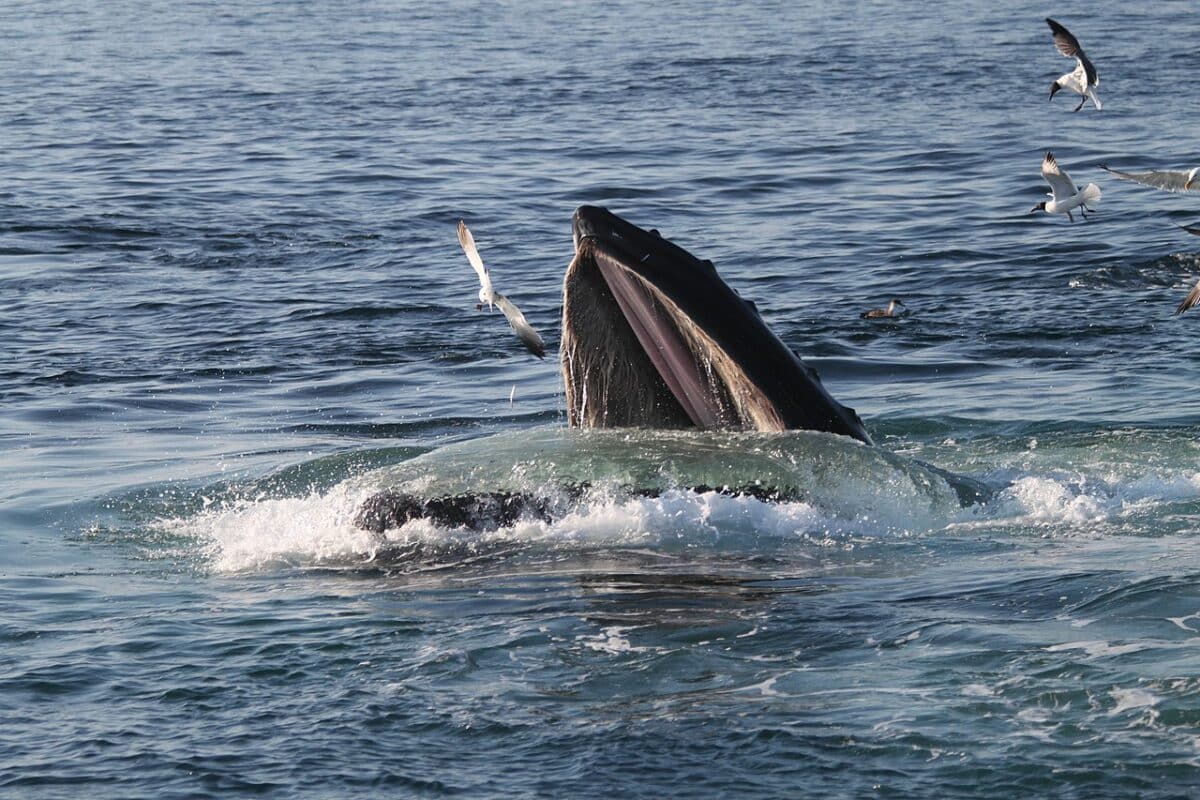
Humpback whales belong to the category of baleen whales. Although it may appear in the image above that the whale might engulf the two kayakers, this encounter will be detailed in another one of our articles.
These whales sieve krill, sardines, and other schooling fish from the water. Some humpbacks display a fascinating behavior known as “bubble nets” to capture their prey. They dive deeply and then ascend in a spiral pattern, simultaneously releasing a continuous stream of bubbles from their blowholes. These bubbles rise to form a “net” that encircles the whales’ intended prey.
Subsequently, the whales swim upward through the center of the bubble net, feeding on the prey ensnared inside.
The diet of these gentle giants also substantiate reasons why they are found in every single ocean around he world. Their food is in abundance. The seasons do drive where they migrate to, as their tiny feed thrives under specific and seasonal conditions.
Breeding
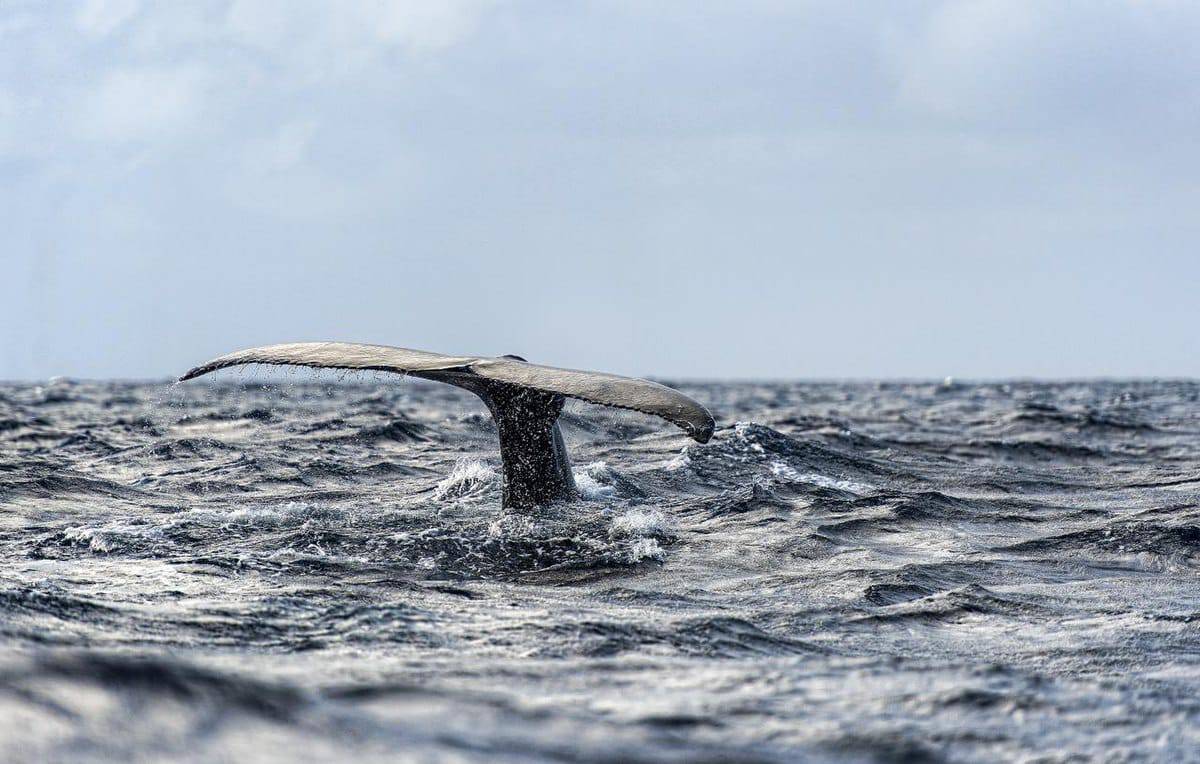
Humpback whales engage in complex courtship behaviors where multiple males compete for a single female. Females become pregnant every two to four years, carrying their calf for about 11 to 12 months.
Calves grow rapidly, adding about 0.5 meters per month by nursing on their mother’s nutrient-rich milk, consuming around 50 kilograms daily in their first year, doubling in size within that time.
Females nurse their newborns in warm, shallow waters. Estimating the age of humpback whales is challenging due to the lack of teeth commonly used for age estimation in other mammals. Nonetheless, they are believed to live up to eighty years.
Conservation
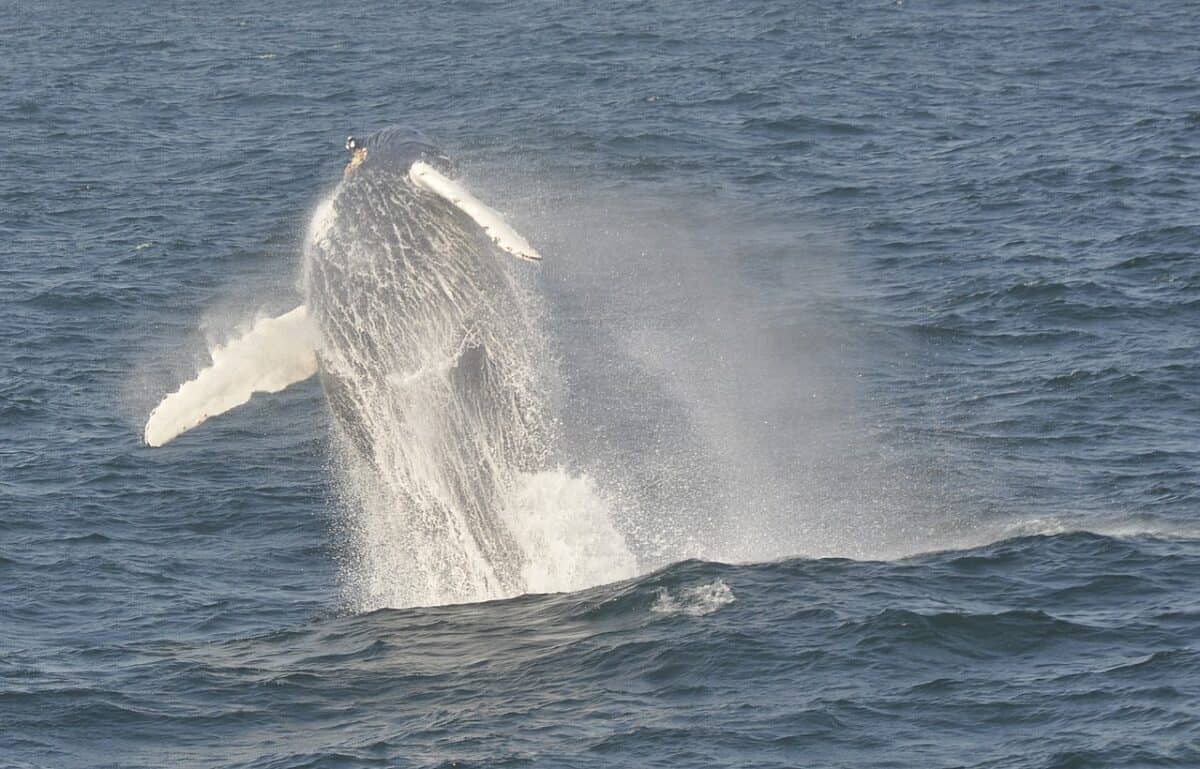
At one time, the humpback whale was brought to the brink of extinction by the whaling industry. By the time the 1966 moratorium went into place, it’s estimated the whale population had fallen by 90 percent.
Today, the species has partially recovered and has a conservation status of “least concern” on the IUCN Red List of Threatened Species.
While the current humpback population numbers of around 80,000 put it at minimal risk for extinction, the animals remain at risk from illegal whaling, noise pollution, collisions with ships, and death from entanglement with fishing gear.
From time to time, certain native populations also receive permission to hunt these innocent whales.
The threat to ocean marine life must always remain a priority. The mass commercial fishing as well as increased transport on the seas is a major concern.
Learn More!
This amazing clip, narrated by Sir David Attenborough, gives an overview and insight into the amazing lives of Humpback whales. This footage is unbelievable- certainly not to be missed.
Frequently Asked Questions (FAQs)
Humpback whales can be found in every ocean in the world. Some popular destinations for whale watching include Tofo, Mozambique, and South Africa. However, it’s important to research and choose a reputable tour operator or organization that focuses on responsible whale watching practices.
Humpback whales can grow to be about 52 feet (16 meters) long and weigh 30-50 tons (27-45 tonnes). They have distinctive features such as giant pectoral fins (up to 16 feet long), dark backs, light bellies, pleats on their throats, and a small hump in front of their dorsal fin. Each humpback whale has a unique pattern of pigment and scars on its underside, similar to a fingerprint.
Humpback whales are known for their complex and beautiful songs. It is believed that males primarily sing to communicate with other whales and attract potential mates. The songs may change over time and are shared by all singing members in the same area, despite the great distances between groups.
Humpback whales are often seen breaching, spyhopping (rising nose-first out of the water), slapping the water with their flukes and pectoral fins, and engaging in other displays. They are powerful swimmers and use their massive tail fin (fluke) to propel themselves through the water. Mothers and their young swim closely together, exhibiting gestures of affection. Females nurse their calves for almost a year, and calves continue to grow until they are about ten years old.
Humpback whales are baleen whales that filter their food through baleen plates. They primarily feed on tiny shrimp-like krill, plankton, and small fish such as anchovies, cod, sardines, mackerel, and capelin. Some humpbacks have been observed creating “bubble nets” to catch their prey.
While Humpback whales were once brought to the brink of extinction due to whaling, their population has partially recovered, and they are currently listed as “least concern” on the IUCN Red List of Threatened Species. However, they still face threats from illegal whaling, noise pollution, ship collisions, and entanglement with fishing gear. Continued conservation efforts are necessary to protect these magnificent creatures.
It is difficult to determine the exact lifespan of Humpback whales due to the absence of teeth, which are typically used to estimate age in other mammals. However, they are believed to live up to about eighty years old.
Further Reading:
Learn all about whale watching or find out where you can swim with Belugas.
Join our Forum for free today!

- Third Elk Incident in Two Weeks in Estes Park, Colorado and How to Stay Safe - July 4, 2024
- 17 Animals That Mate For Life - June 24, 2024
- 13 Animals That Lay Eggs (Some Might Surprise You!) - June 16, 2024

